In this article:
eOrdering Legacy Configuration
From Orchid SP1, if you have existing eOrdering contacts set up in Bp Premier, when you select View > Contacts > Setup > eOrdering, the Existing eOrder Contacts Detected screen will appear and you will be asked to merge your existing contacts with corresponding providers listed on the screen.
Merge eOrdering provider contacts
Providers listed in the eOrdering setup screen are partnered with Best Practice Software, and will be added and updated regularly via Data Updates.
IMPORTANT There is a known issue in which Laboratories configured for legacy eOrdering that have been merged with enhanced eOrdering contacts, do not retain their laboratory code.
Best Practice Software recommend noting the Laboratory Code prior to merging legacy eOrdering contacts with enhanced eOrdering contacts, as it will need to be entered again once the merge is complete.
- Follow the instructions on the screen to merge your existing eOrdering contacts with the listed providers.
- Once you have selected the records you wish to merge and clicked Merge Record(s), The Merge Records screen will appear. From the existing contacts list, select a primary contact to retain its user preferences and eOrdering path.
-
If you did not select a primary contact in step 2, you will have the option to set the eOrder path for the provider. Enter the path that the merged eOrdering contact used previously, and click Save. If you are unsure of what path should be used, contact the provider.
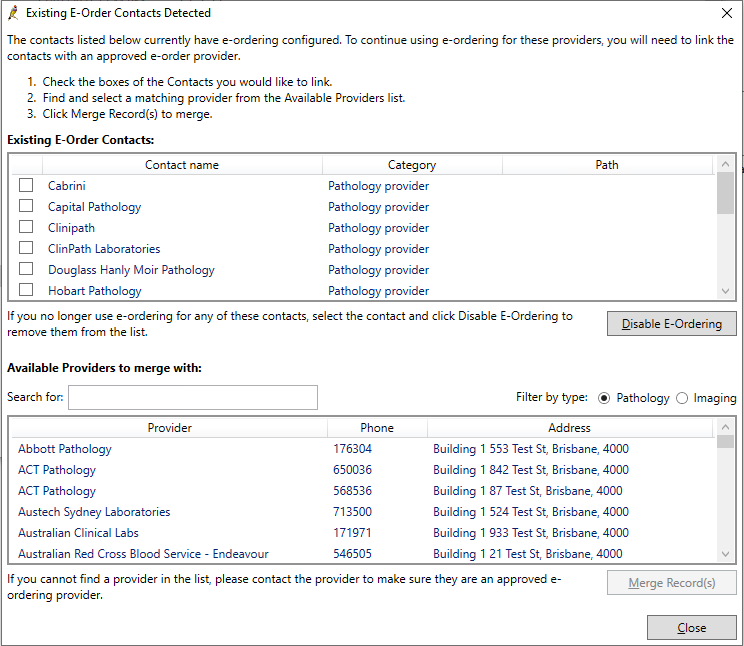
When the contacts are merged, pathology user favourites, as well as preferred lab, eOrder export path, Location Lab codes, 'Use plain paper' or 'Paper has specimen labels' along with the mm values for the primary contact are preserved.
NOTE Perform the merge for each available provider that has corresponding existing contacts.
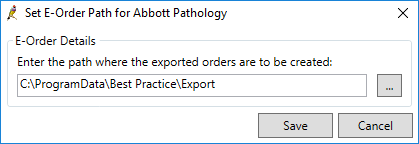
The Setup eOrdering screen will appear.
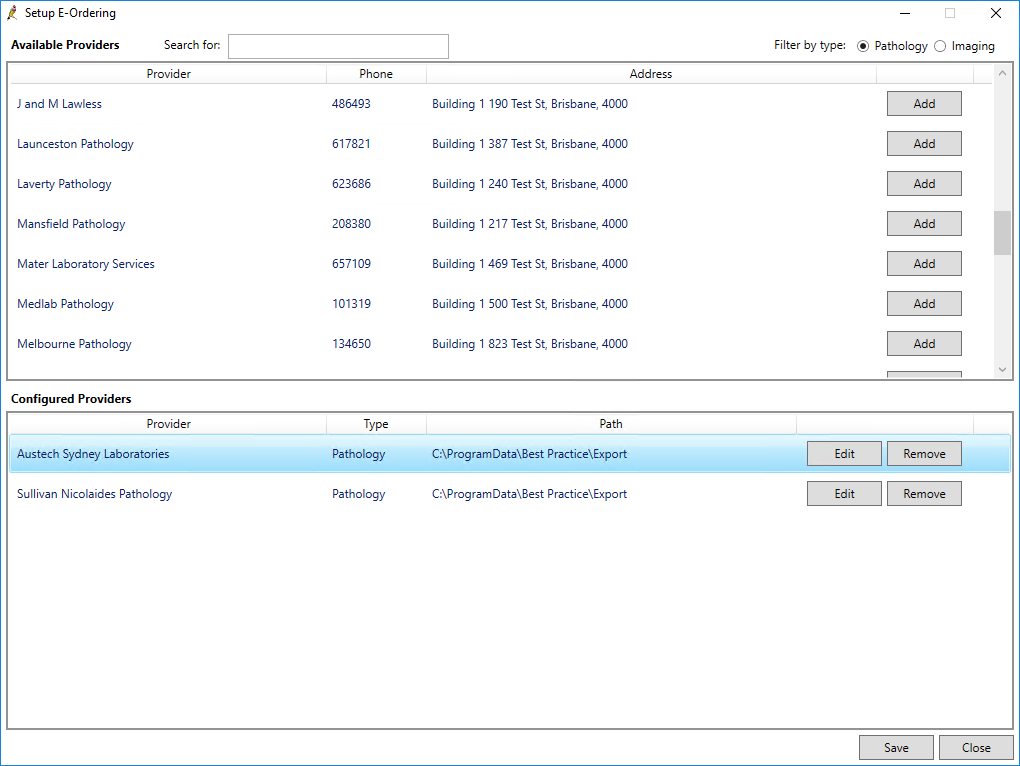
Managing Duplicate eOrder Contacts
In Orchid SP1, the potential duplicates window will be displayed when adding a new eOrdering contact in Setup > eOrdering if Bp Premier detects a laboratory contact with a similar name. Potential duplicates will be displayed for both existing eOrdering laboratory contacts and laboratory contacts not using eOrdering. The potential duplicates window allows the user to create a new eOrdering contact or merge with potential duplicates.
- From the Bp Premier home screen on your server, select View > Contacts. The Contacts screen will appear.
- Select Setup > eOrdering from the menu at the top of the page. The Setup eOrdering screen will appear.
- Search for the pathology provider you wish to configure, and click Add.
- If Bp Premier detects an existing contact with a similar name, it will display the Potential Duplicates window. The potential duplicates window allows the user to create a new lab or merge with potential duplicates.
- If you choose to create a new eOrdering contact, the Configuration settings for the laboratory will be displayed. For information on configuring eOrdering Labs, see Configure eOrdering Providers.
- If you choose to merge contacts, tick the box next to the Laboratory name and then click Merge with selected and the Configuration settings for the laboratory will be displayed. For information on configuring eOrdering Labs, see Configure eOrdering Providers.
Potential duplicates will be displayed for both eOrdering laboratory contacts and non-eOrdering laboratory contacts.
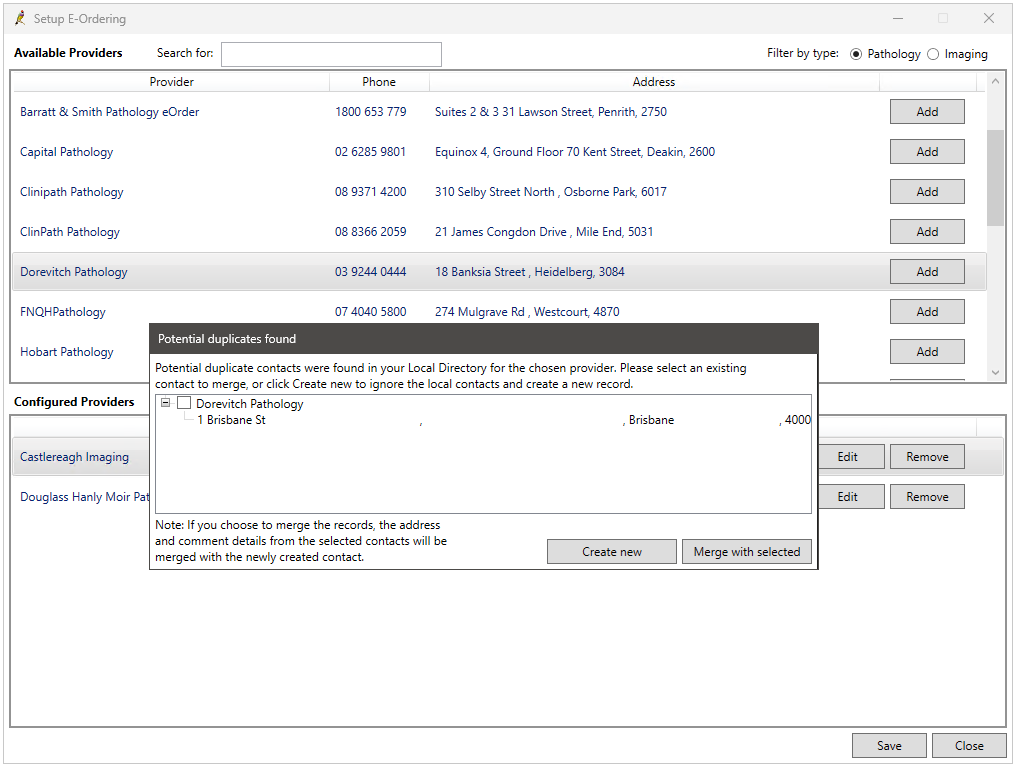
NOTE By selecting to merge the records, the address and comment details from the selected contacts will be merged with the newly created contact.
Configure Imaging providers
- Access the eOrdering setup screen on your practice server.
- Ensure Imaging is selected in the top right-hand corner. A list of imaging providers will be available.
- Search for the imaging provider you wish to configure, and click Add. Configuration settings for the imaging provider will appear.
If the imaging provider you wish to set up for eOrdering is not listed in the eOrdering setup screen, ask the imaging provider to contact the Best Practice Software Partnerships team at partners@bpsoftware.net .
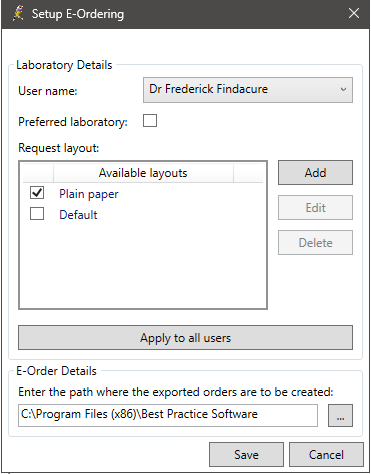
Configure imaging provider details
If you have Add/Edit/Delete permissions set for User preferences, you can add default preferences for the whole practice by configuring imaging provider details and clicking Apply to all users. You can also add preferences for other users by selecting them from the User name menu.
Once the practice defaults are set, if you have Add/Edit/Delete permissions set for Own preferences, you can change your own settings as required.
- From the User name: menu, select the user whose imaging provider details you wish to configure.
- Indicate whether the imaging provider is a preferred provider.
- Select the layout you wish to use for the imaging request from the layouts under Request layout.
- Click Apply to all users to apply the current imaging provider details to all users.
If the imaging provider requires you to use preprinted stationery and they have provided a layout, the provided layout will be called Default. Provided layouts will have coordinate information pre-populated.
Provided layouts will be added in data updates. Provided layouts cannot be edited.
If the imaging provider requires you to use preprinted stationery and they have not provided a layout, you will need to create a layout that suits their stationery. Click Add. The Add Layout screen will appear.

Enter a name for the layout and add the measurements in mm from the top left corner of the page for each element. Click Save. The new layout name will now appear under Available layouts.
Configure preferred address details for a laboratory
To make it easier for patients to find the closest laboratory, Providers can include the address of a nearby preferred laboratory on printed copies of eOrdering requests.
- Select View > Contacts or press F11 from the main Bp Premier screen. The Contacts screen will be displayed.
- Search for the Pathology or Imaging Laboratory and click Edit.
- Based on the information the laboratory has given to Best Practice Software, the Addresses section will already have one address filled in. Click Add and Enter the details for the Preferred Local Laboratory and click Save.
- The newly Added address and Contact information will appear on the Printed eOrdering request when the laboratory layout is set to Plain paper.
- From the Contacts screen, select Setup > eOrdering from the menu at the top of the page. The Setup eOrdering screen will appear.
- Locate the Laboratory under the Configured Providers section and click Edit.
- If all Providers use the Plain Paper format, click Apply to all users; otherwise, configure each relevant user individually, then click Save.
- Click Save on the Setup eOrdering Utility screen to confirm the changes are applied.
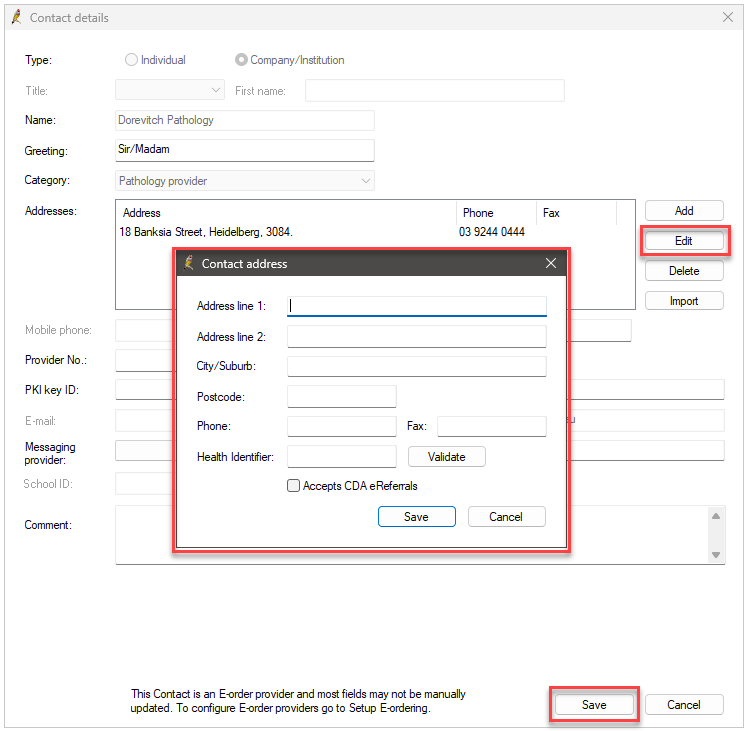
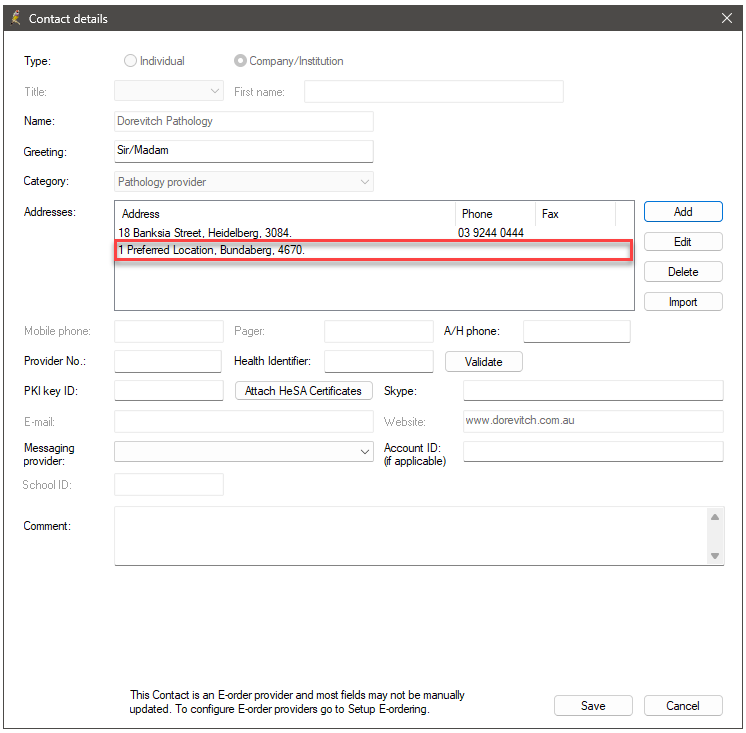
NOTE There is no restriction on how many additional addresses can be added to a contact. However, only one of them will be visible on the eOrdering request. The address will be taken from the first custom entry made in the address details.
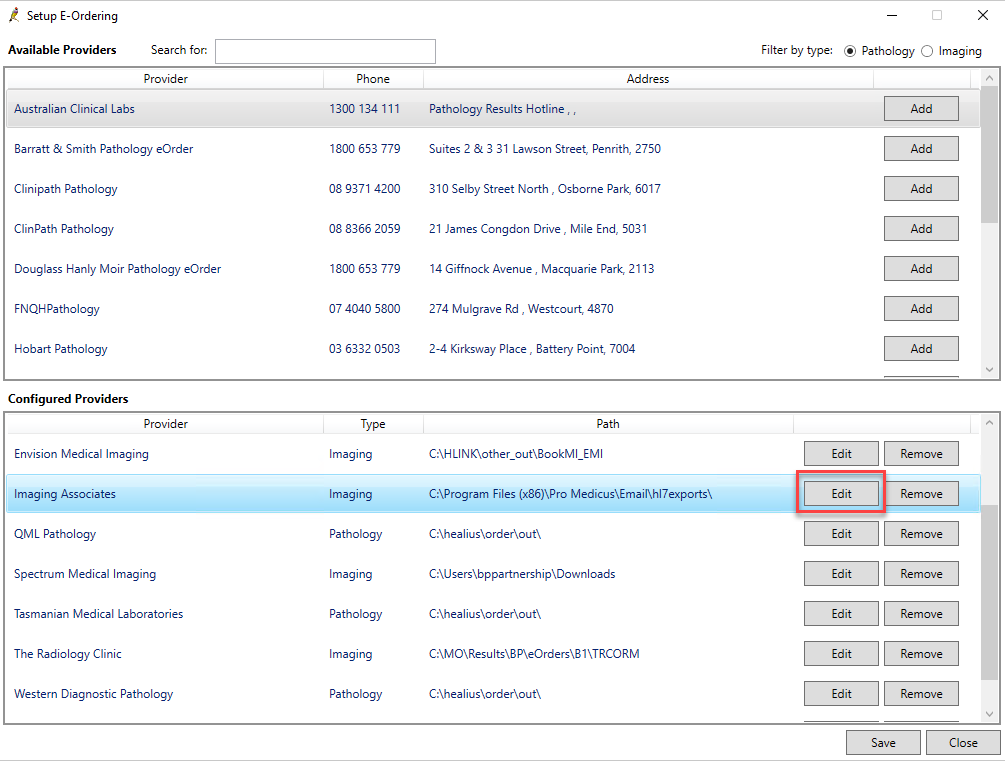
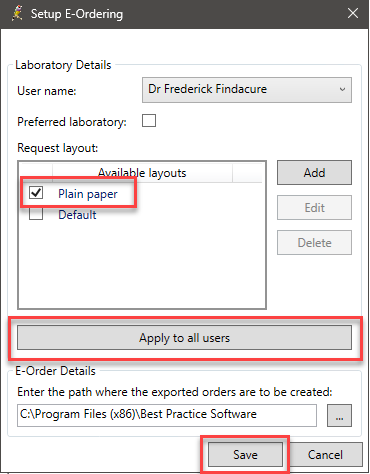
NOTE Users must first log out of Bp Premier and then log back in for the updates to take effect.
Configure eOrder details
Enter the path on this machine to store electronic requests, or browse to the folder you wish to use by clicking the ellipsis button. The imaging provider can tell you if eOrder files need to be in a specific folder.
If the nominated folder does not exist, Bp Premier will create the folder.
Testing eOrder generation
- Test creating an eOrder request from both the server and a client machine after setting your eOrder provider.
- Before making requests, make sure the BP Messaging Service is set up and operational. See Troubleshoot Bp Messaging Service for more information.
- Confirm that the ORM HL7 files are being successfully generated to the file path set for the lab.
- The following script, which displays the eOrder records and reports their status, can be used to determine whether the creation was successful or failed as a result of an issue.
- Download the script file Display_eOrderLog_Status.bpscript here.
- Run the downloaded script on the Bp Premier server using the Bp Script Runner Utility. Instructions on running Bp Script Runner are available here.
Remove a configured provider
- From either the pathology or imaging provider screen, select Remove next to the provider you wish to remove. A message will appear asking for confirmation that you wish to remove the provider, and if the provider's contact record should be deleted.
- Select Delete linked contact record if you wish to delete the contact record as well, and click Yes to remove the provider.
If you choose to remove the e-ordering provider, but you do not wish to delete the provider's contact record, supplied information such as the provider's address will still be removed.
Notification of failed eOrders
In Orchid SP1, at 6 am, an internal message will be sent to the Practice Manager and Principal Doctor to inform them of any failed eOrders. The message will guide the users to take action by checking 'Only show failed eOrders' in View > Investigation Requests.
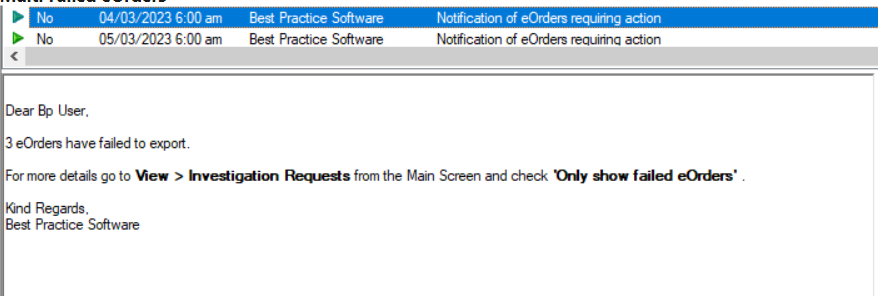
Manage investigation requests
In Orchid SP1, three new columns have been added to the View > Investigation Requests screen:
- The eOrder column contains a yes or no value to indicate whether the investigation request was sent as an eOrder.
- The eOrder created on column will show the date and time the eOrder was sent and a failed status for any that did not send.
- The barcode column will display the barcode number that appears on the eOrder.
- Select View > Investigation requests from the main Bp Premier screen.
- Filter the requests displayed to a date range.
- Select from the By doctor drop-down list to only show requests from a specific provider.
-
To resend eOrders, right-click on the investigation request and click Resend eOrder or click on the investigation request, select Edit from the menu and then click Resend eOrder.
-
Bp Premier cannot determine automatically that a request has been received in entirety, because this data is not provided in the result file from the laboratories. You can, however, determine if at least some of the request has been returned:

|
Filter |
Description |
|---|---|
|
Include already returned |
Tick to include investigation requests that have had results returned by a pathology lab. |
|
Only show eOrders |
Tick to only show investigation requests that have been sent as eOrders. |
|
Only show failed eOrders |
Tick to only display investigation requests that were sent as eOrders but the transmission failed. |
When successfully transmitted, the status will be updated from failed to the date and time it was sent successfully.

eOrders that were successfully transmitted can be resent, and an on-screen prompt will ask you to confirm that it’s required.
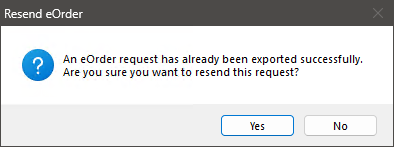
NOTE Best Practice Software recommends eOrders only be resent if there is a confirmed issue with the initial eOrder transmission.
Where the result is shown in green and has a Status of ‘Partial’, the request has been partially received. This status relies on the laboratory including the order number from your request in the returned result file.
If the result has not been returned (even partially), or the laboratory has not used the order number, the request will show in pink with a status of ‘Outstanding’.
NOTE To view an investigation request for a single patient, select Request > List from the patient record. The Investigation requests screen will appear.
Last updated: 17 August 2023.